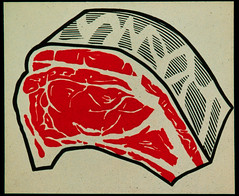I did finally get around to making my garbage plates, which is a specialty of Rochester, NY. A friend of mine had brought me a package of Zweigle’s White Hots, which is an emulsified brat-like sausage from Rochester, NY. A garbage plate has two side dishes, a couple of white hots (you can get other things like red hots, or hot dogs instead), white bread and a chili-like sauce. For the sides you can choose two of the following: French fries, home fries, macaroni salad, or baked beans.
I conferred with my friend because I was unclear if everything was kind of piled on together, or if things were separate. He grew up a few blocks from the original Nick Tahou’s, which invented the garbage plate, but warned me that his recollections of them would be filtered by the fact that he rarely ate them when he was stone cold sober. This fact is, to my mind, part of the appeal. A garbage plate is something you eat late at night after you’ve been out drinking with friends. In many respects, this would make it similar to White Castle Hamburgers, which were a favorite of many friends I had growing up in NY after they had been out drinking. In any event, my friend’s advice was sound. The sides are sort of separate, and the white hots and chili sauce go over the top. You can get to the individual sides, but part of them is also covered with the white hots and sauce.
We had made some barbecue over the weekend and had some leftover baked beans, so that was an obvious choice for one side. I opted to do some oven fries as the other. The white hots are traditionally butterflied and grilled. I had been given the popover type of white hots, so I didn’t butterfly them assuming instead that the heat of cooking would pop them open (a bad assumption on my part actually, since they never popped). The chili-like sauces was out of David Rosengarten’s excellent, It’s All American Food, which is one of the best ethnic and regional American cookbooks I’ve seen. I did a variation of the traditional plating. I put the beans and potatoes on the plate, but put some white bread down as well. The white hots went over the bread (primarily, although they did flop onto other things), and then poured the sauce on.
One other difference was that I was eating my garbage plate as dinner, and not at 2am in the morning. Unlike most garbage plate diners, I would have my beer with it and not before. In many ways this is a dish like barbecue, which requires a lighter bodied, versatile beer. I opted to go with my Belgian Summer Ale (which is about 20% wheat and about 5% alcohol), because it’s easy drinking and light and wouldn’t interfere with the delicious, gooey mess that is a garbage plate. Another good choice would have been one of the leftover bottles of Session lager form last weekend’s barbecue. It fits the bill in a similar way.
The meal was delicious and satisfying and made me think and some of the things that David Rosengarten talks about in his book. David Rosengarten is a food critic, TV cook, and cookbook author. He knows high brow food and knows how to cook. He was a high profile critic in NY and reviewed an astounding number of restaurants in the early days of the culinary revolution in the US. What’s refreshing about his book on American food, is that he realizes that great food doesn’t necessarily mean high brow food. For instance, he prefers a hamburger with Heinz ketchup instead of fancy house-made ketchups that a lot of restaurants were doing in the late 1980’s and early 1990’s. He understands the importance of Hellmans (or Best Foods) bottle mayonnaise vs. homemade. Each has their place, and neither is necessarily a replacement for the other. In a word, he knows how to “slum it” in the culinary world and he’s big enough to not care what others think.
He’s not alone in this either. Many well known cooks and critics like some foods that most foodies (including me at one point) would consider “low brow” and beneath them. Julia Child was fond of Goldfish crackers (which are still one of my weaknesses), and James Beard had a penchant for Kentucky Fried Chicken. I have also been told about a local French chef who after a large service at the International Pinot Noir Celebration (and apparently many glasses of wine) was seen a couple of hours later in a tavern scarfing down a plate of chicken wings and drinking a beer. There’s a lot of snobbiness in the food world, and probably more in the wine world (and there are certainly more than a few beer snobs around, including myself). In this upscale world of cuisine, there doesn’t seem to be a place for garbage plates, Goldfish, Buffalo wings, or bottled mayonnaise. But no one can deny how good some of these foods can be. I wouldn’t expect to see a garbage plate at Le Circe, but that doesn’t mean you can deny how good it tastes. Pick up a copy of Rosengarten’s book and he’ll help you rediscover that a lot of those foods you love but don’t like to admit to, are really that good when they’re made right. After all, if they had never been good, they would never have become so popular.
Tuesday, August 14, 2007
Garbage Plates (and David Rosengarten)
Posted by
Bill
at
4:24 PM
![]()
![]()
Labels: david rosengarten, garbage plate, zweigle's
Subscribe to:
Post Comments (Atom)

No comments:
Post a Comment